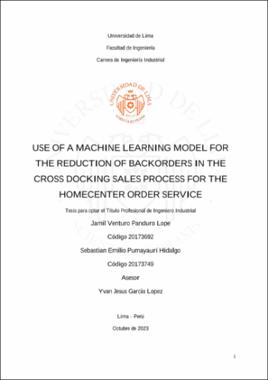Mostrar el registro sencillo del ítem
Use of a Machine Learning model for the reduction of BackOrders in the Cross Docking sales process for the Homecenter Order Service
| dc.contributor.advisor | García López, Yván Jesús | |
| dc.contributor.author | Panduro Lope, Jamil Venturo | |
| dc.contributor.author | Pumayauri Hidalgo, Sebastian Emilio | |
| dc.date.accessioned | 2024-01-26T15:38:55Z | |
| dc.date.available | 2024-01-26T15:38:55Z | |
| dc.date.issued | 2023 | |
| dc.identifier.citation | Panduro Lope, J. V. & Pumayauri Hidalgo, S. E. (2023). Use of a Machine Learning model for the reduction of BackOrders in the Cross Docking sales process for the Homecenter Order Service [Tesis para optar el Título Profesional de Ingeniero Industrial, Universidad de Lima]. Repositorio institucional de la Universidad de Lima. https://hdl.handle.net/20.500.12724/19794 | es_PE |
| dc.identifier.uri | https://hdl.handle.net/20.500.12724/19794 | |
| dc.description.abstract | In this work, it is necessary to analyze the increase of Back Order in the attention of crossdocking orders in the attention of Homecenter customers due to the lack of definition of purchase planning processes, resulting in logistics costs, fill rate charges and low service level. Thus, it is intended the companies that handle high volumes of inventory and constant orders should have a forecast plan to cover possible stock-outs. The main purpose of the research is to explain a way to prevent stock-outs using an artificial intelligence model, based on historical sales data of a medium-sized company that manages inventories, as well as to determine the machine earning model to predict and reduce backorders. For the data analysis, the Orange software was used, where the data was trained with different artificial intelligence models such as Decision Tree, Support Vector Machine, Random Forest, and neural networks. The most accurate model was defined according to numerical indicators such as the confusion matrix, the area under the curve (AUC) and the ROC curve analysis. Thus, we opted for the neural network model, which presented the most accurate data. | en_EN |
| dc.description.abstract | En el presente trabajo se precisa analizar el aumento de BackOrder en la atención de pedidos crossdocking en la atención de clientes Homecenter debido a la no definición de procesos de planeación de compras, derivando en costos logísticos cobros de fill rate y bajo nivel de servicio. De tal forma se pretende que las empresas que manejan alto volúmenes de inventario y pedidos constantes, deben contar con un plan de pronóstico para cubrir posibles quiebres de stock. El principal propósito de la investigación es explicar una forma de prevenir roturas de stock usando un modelo de inteligencia artificial, basado en data histórica de ventas de una mediana empresa que maneja inventarios, así mismo se planteó el objetivo de determinar el modelo de machine learning para predecir y reducir los Backorders Para el análisis de data se utilizó el Sotfware Orange, donde se entrenó la data con diferentes modelos de inteligencia artificial como Árbol de decisiones, Maquina de soporte de vectores, bosque aleatorio, y redes neuronales. Donde se definió el modelo más preciso de acuerdo a indicadores numéricos como la matriz de confusión, el área bajo la curva (AUC) y el análisis de la curva ROC. Optando así por el modelo de redes neuronales, modelo que presentó datos más precisos. Finalmente se presenta los resultados y se realiza la sugerencia a nivel de gerencia sobre la toma de decisiones en el proceso de abastecimiento. Para ello se considera pertinente ahondar en el tema de las variables influyen la acumulación de backorders. | es_PE |
| dc.format | application/pdf | |
| dc.language.iso | eng | |
| dc.publisher | Universidad de Lima | |
| dc.rights | info:eu-repo/semantics/openAccess | * |
| dc.rights.uri | https://creativecommons.org/licenses/by-nc-sa/4.0/ | * |
| dc.source | Repositorio Institucional - Ulima | |
| dc.source | Universidad de Lima | |
| dc.subject | Aprendizaje automático | es_PE |
| dc.subject | Gestión de stocks | es_PE |
| dc.subject | Adquisiciones en la empresa | es_PE |
| dc.subject | Machine learning | es_PE |
| dc.subject | Inventory control | es_PE |
| dc.subject | Industrial procurement | es_PE |
| dc.title | Use of a Machine Learning model for the reduction of BackOrders in the Cross Docking sales process for the Homecenter Order Service | es_PE |
| dc.type | info:eu-repo/semantics/bachelorThesis | |
| thesis.degree.level | Título Profesional | |
| thesis.degree.discipline | Ingeniería Industrial | es_PE |
| thesis.degree.grantor | Universidad de Lima. Facultad de Ingeniería y Arquitectura | |
| dc.publisher.country | PE | |
| dc.type.other | Tesis | |
| thesis.degree.name | Ingeniero Industrial | |
| renati.advisor.orcid | https://orcid.org/0000-0001-9577-4188 | |
| renati.discipline | 722026 | |
| dc.identifier.isni | 121541816 | |
| renati.author.dni | 73054202 | |
| renati.author.dni | 76043474 | |
| renati.level | https://purl.org/pe-repo/renati/level#tituloProfesional | * |
| renati.advisor.dni | 6074453 | |
| renati.juror | Chávez Ugáz, Rafael | |
| renati.juror | Taquía Gutiérrez, José Antonio | |
| renati.juror | García López, Yván Jesús | |
| renati.type | https://purl.org/pe-repo/renati/type#tesis | * |
| dc.subject.ocde | https://purl.org/pe-repo/ocde/ford#2.11.04 | |
| ulima.cat | 9 |
Ficheros en el ítem
Este ítem aparece en la(s) siguiente(s) colección(ones)
-
Tesis [1167]





